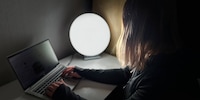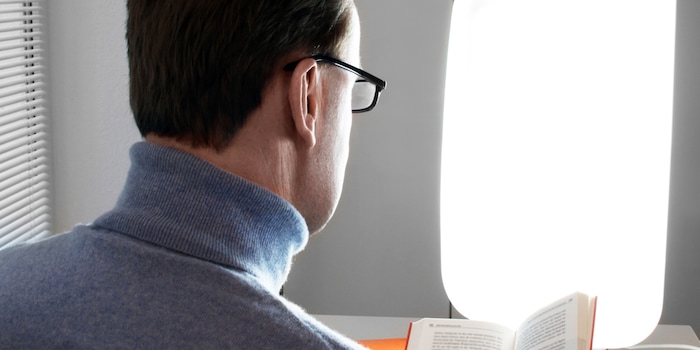
Background information
Tried it out: Awake and in a good mood thanks to a daylight lamp?
by Anna Sandner

Tired, listless and in a bad mood in winter? Then light therapy can help. Daylight lamps can improve your sleep-wake rhythm and alleviate depressive symptoms.
What do many people lack in winter? Exactly, enough light! The seasonal lack of light can even lead to winter depression. It is not uncommon for a sluggish tiredness to pervade the grey day. Light therapy can counteract this by stimulating activating metabolic processes in the brain. In short, it stops the production of the "sleep hormone" melatonin and promotes the release of mood-enhancing neurotransmitters such as serotonin and noradrenaline. As a result, a daily half-hour light shower in the morning has been proven to relieve depressive symptoms of winter depression, mood enhancement and improvement of the sleep-wake rhythm.
Daylight lamps use light with a broad spectrum that is similar to natural sunlight. They should have an illuminance of 2500 to 10000 lux. This value indicates how much light falls on a surface per square metre. For comparison: normal room lighting only has around 300 to 500 lux.
I wanted to feel the effect for myself and started my days with a light shower for a fortnight as part of my trial and error series. You can read how it worked for me here:
In order for the light shower to be effective, you should sit in front of it for about half an hour a day. You do not have to and should not look directly into the lamp. It is sufficient if the light falls on the side of the retina of your eyes. The distance is crucial: the further away you sit from the lamp, the longer it should be used. You will find precise information in the instructions for your light therapy lamp. As a rule, illuminance and duration of use are inversely proportional to the distance from the lamp. In other words: At 10000 lux illuminance and a distance of 10 centimetres, an application of at least 30 minutes is recommended. If you double the distance to 20 centimetres, the lux value halves to 5000 and you should enjoy the light for at least one hour to achieve the same effect.
The full effect of light therapy typically unfolds after around two to three weeks of regular use. However, initial improvements in symptoms can often occur after just a few days.
There are differences in effectiveness between different types of light therapy lamps. The main factors are the illuminance (measured in lux), the colour temperature (in Kelvin) and the illumination area. Lamps with a higher lux number (10000 lux or more) and a cooler colour temperature (5000 to 6500 Kelvin) are generally more effective. The larger the lighting surface, the more light is also emitted.
I have already briefly mentioned that a daylight lamp stops the production of the sleep hormone melatonin. This allows you to practically "set" your internal clock. This works best in the early hours of the morning right after waking up.
Taking a light shower in the early afternoon doesn't help much. At least it has very little effect on your internal clock, as it is insensitive to light at midday.
Conversely, this also means that you should stop looking at the therapy lamp in the evening before going to sleep so that you don't unnecessarily keep your internal clock on its toes at night.
You can read more about the internal clock and the sleep-wake rhythm in the interview with chronobiologist Henrik Oster:
It is therefore not recommended to use the light shower in the evening. You should also avoid looking directly into the lamp for long periods of time so as not to overstimulate your eyes. With some models, however, it is definitely recommended to look directly into the light for short periods of time. Nevertheless, caution is advised, otherwise headaches, irritated eyes or dry skin may occur. To really achieve a noticeable improvement, it is also important that you do not keep the application too short and repeat it regularly.
The possible side effects are therefore limited. Nevertheless, there are cases in which light therapy is not advisable. People with epilepsy, for example, especially those with light-sensitive forms, should be careful, as light stimuli can trigger seizures. Caution is also advised for people with eye diseases such as age-related macular degeneration, retinal problems or glaucoma. People with bipolar disorders, especially during manic phases, should also only use the therapy under medical supervision. In addition, certain medications can increase sensitivity to light, including some antidepressants, neuroleptics and antibiotics. If you have skin diseases such as lupus erythematosus or a history of skin cancer, you should also discuss this with a doctor before use.
Most people in northern climes also suffer from a vitamin D deficiency in winter due to the lack of sunlight. It therefore seems logical to think that light therapy that imitates natural sunlight can also replenish vitamin D stores. However, this is not the case for one simple reason: in order to produce vitamin D, the body needs UV light, more precisely UV-B radiation. Daylight lamps, however, emit visible light with a colour temperature of around 5000 to 6500 Kelvin. This is similar to natural daylight at midday and can have the described effect on the sleep-wake rhythm, but does not contain any UV radiation. Although this means that vitamin D cannot be produced, there is also no risk of skin cancer developing as a result of light therapy.
Science editor and biologist. I love animals and am fascinated by plants, their abilities and everything you can do with them. That's why my favourite place is always the outdoors - somewhere in nature, preferably in my wild garden.
Practical solutions for everyday problems with technology, household hacks and much more.
Show all